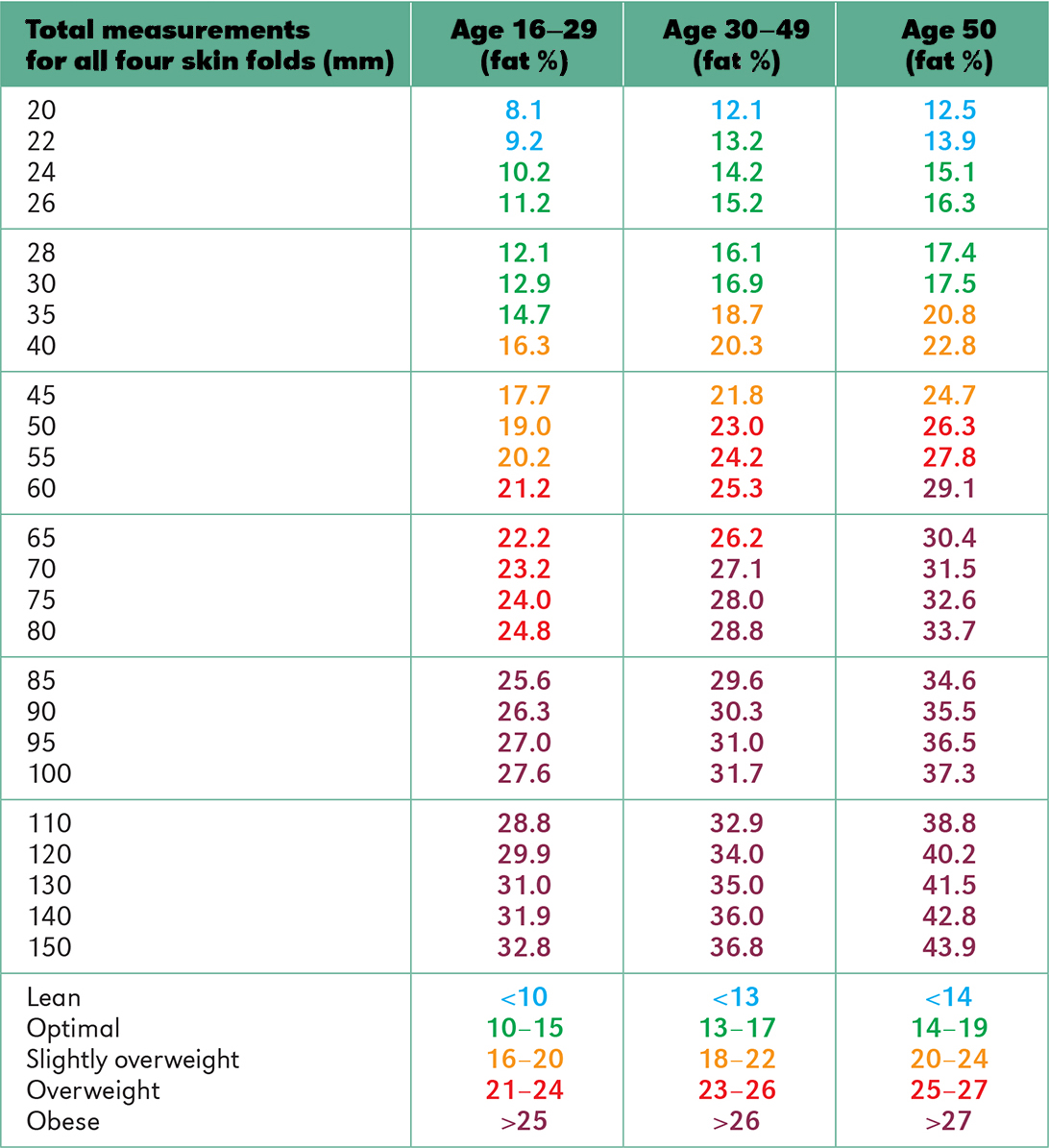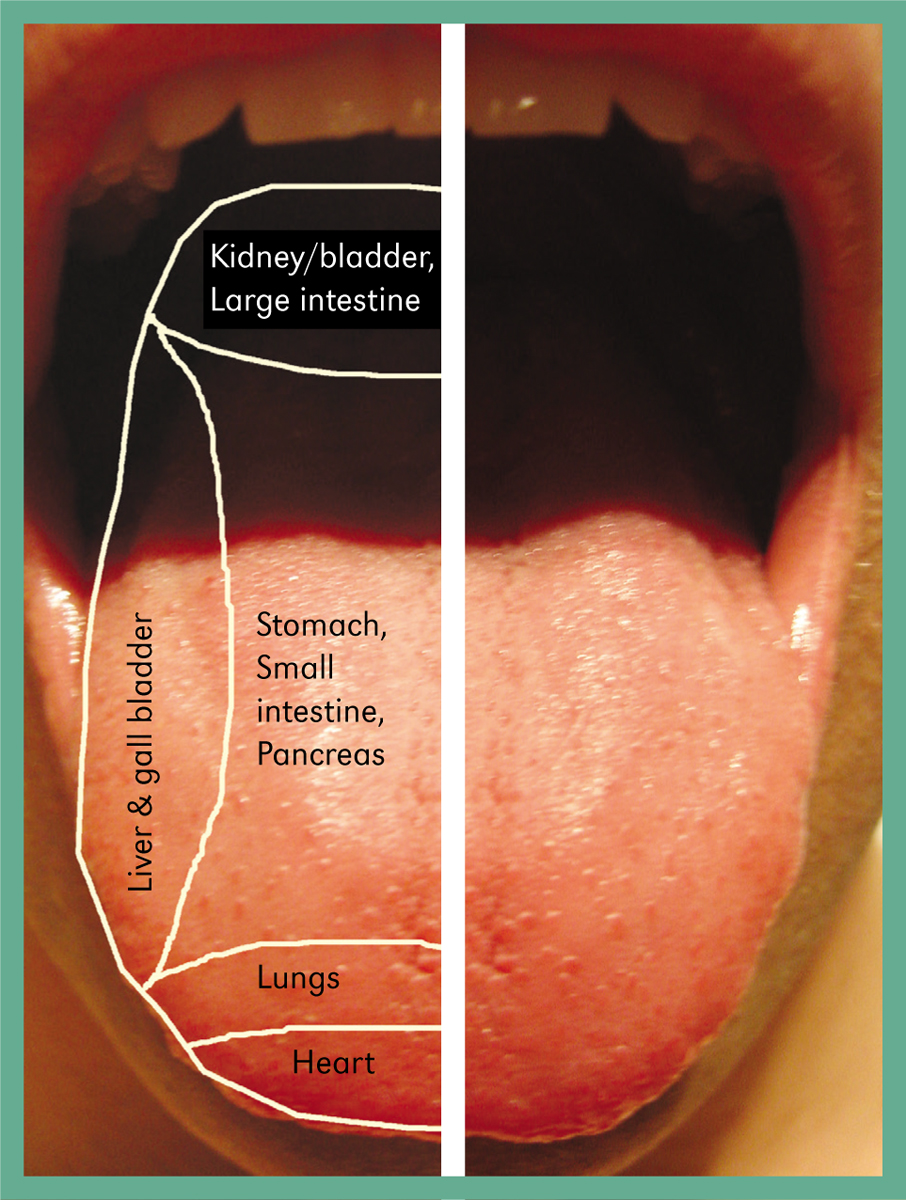
Week 1 – please note the teeth marks on the side of my tongue and the slightly red tip. Both of these signs indicate poor nutrition, something that the 12-week nutrition programme helped me to alleviate by eating a healthy balanced diet.
02 KNOWING YOUR BODY INSIDE AND OUT
It is important to know your body inside and out. What is normal for you may not be normal for someone else, and vice versa. Everyone can say that they have noticed things about their body that were not normal for them at one time or another. Your body talks to you all the time, perhaps only in subtle measures, but by learning to read these signals it will enable you to act on anything that may be upsetting your well-being or disturbing your equilibrium.
The signs may be small, and you may feel that they are even unimportant, like having yellow fingers, for example. This could simply be a result of nicotine discolouration – however, it could also be a warning sign for a disorder in your liver or lungs. Try not to take anything for granted.
Knowing how to differentiate between these small signals before they turn into the actual symptoms of a disorder is a delicate matter, and should not be rushed. The following information is an easy reference guide to highlight some things that may be troubling you, and how you can watch out for signs of poor health in your own body.
TONGUE
We can detect a lot about the health of a person by looking at aspects of their tongue, such as changes to the shape, size, colour, texture and coating. In fact, the tongue is still used today in Chinese medicine to help diagnose various health concerns. The tongue is covered with several types of papillae or nodules that continually shed and grow like hair, making it a great source of information about our health.
This is a guide for a healthy tongue:
•Size and shape – normal and proportionate to the body
•Colour – salmon or pinky red shade
•Texture – smooth with no marks or cracks
•Coating – thin, white, moist coating across the whole tongue
Here are some things to look out for when investigating your tongue. These could be caused by different conditions or could well be an indication of possible problems within certain body systems. Remember, this is just a guideline.

Week 1 – please note the teeth marks on the side of my tongue and the slightly red tip. Both of these signs indicate poor nutrition, something that the 12-week nutrition programme helped me to alleviate by eating a healthy balanced diet.
SIZE AND SHAPE
Big and unusually red – the protective papillae could be being damaged, for example, by teeth or dentures rubbing on the tongue.
Swollen – this could be due to poor digestion. For swollen sides of the tongue, it could be that the liver is being overworked, or there is a problem within the gallbladder.
COLOUR
Unusually red – possibly acute fever. If it is also smooth, it may indicate a vitamin B12 deficiency or an intestinal disorder where nutrients are not being adequately absorbed.
Red tip – indication of depression, a lack of sleep or stress.
Pale – possible lack of nutrients within the body such as vitamin B12 or folic acid. It may also be caused by a hormone imbalance.
Purple – poor circulation, poor nutrition or a lack of vitamin B complex and minerals.
TEXTURE
Peeling – dry mouth or a deficiency in vitamin B.
Teeth marks – normally occurs with a swollen tongue and could suggest digestion problems.
Scrotal tongue – an indication of an infection or poor nutrition.
Groovy tongue – something people are usually born with, and may not be noticed right away. It tends to become more noticeable as you age.
COATING
White – indication of the recovery from a recent fever or a poor diet lacking in fibre.
Black – possible reaction to antibiotics or to stomach medication. Poor oral hygiene, smoking, excessive use of mouthwash, infection, digestion or poorly managed diabetes may also cause this.
Brown and yellow – trapped bacteria and food or excessive smoking and coffee. Yellow coating is normally seen with a red tip.
TEETH AND GUMS
We all want those pearly white teeth and healthy gums to give the biggest and best smile imaginable. As a rule, I will usually brush my teeth twice a day, but please note that if you are following the information below visit your dentist when it is next convenient.
Here are some things to look out for when investigating your teeth and gums. These could be caused by different conditions, or could well be an indication of possible future dental problems, so please consult your dentist if you have any concerns at all.
TEETH
Sensitive – caused by the thinning of your enamel layer (the outer layer that protects your inner dentine), which causes the dentine underneath to become exposed. Dental erosion, gum recession, gum disease, cracked tooth, tooth fillings and teeth bleaching can all lead to sensitive teeth.
Movement – there is a natural tooth movement that occurs throughout your life. It could be due to a tooth that is about to fall out, trauma, advanced gum disease or, if you are missing a tooth, the teeth on either side can move to fill in that space.
Discolouration – an indication of a poor diet, or caused by coffee, soft drinks, tobacco, poor dental hygiene, disease, medication, trauma, advanced ageing or using the wrong toothpaste.
GUMS
Pain – this could be due to an injury, dental disease, tooth decay, scurvy, vitamin B deficiency, iron deficiency, Behçet’s or Reiter’s Syndrome.
Swelling – could be an indication of gum infection, monilia, oral fungal infection, gum disease, gingivitis, poorly fitted dentures, toothpaste or mouthwash allergies. It could also be a possible sign of malnutrition.
Bleeding – this could be due to trauma, disease, mouth sores, systemic conditions, pregnancy and hormonal changes, medication, and vitamin C and K deficiencies.
LIPS
Dry and cracked lips could be caused by external factors such as cold weather, or may be a symptom of dehydration or a nutritional deficiency.
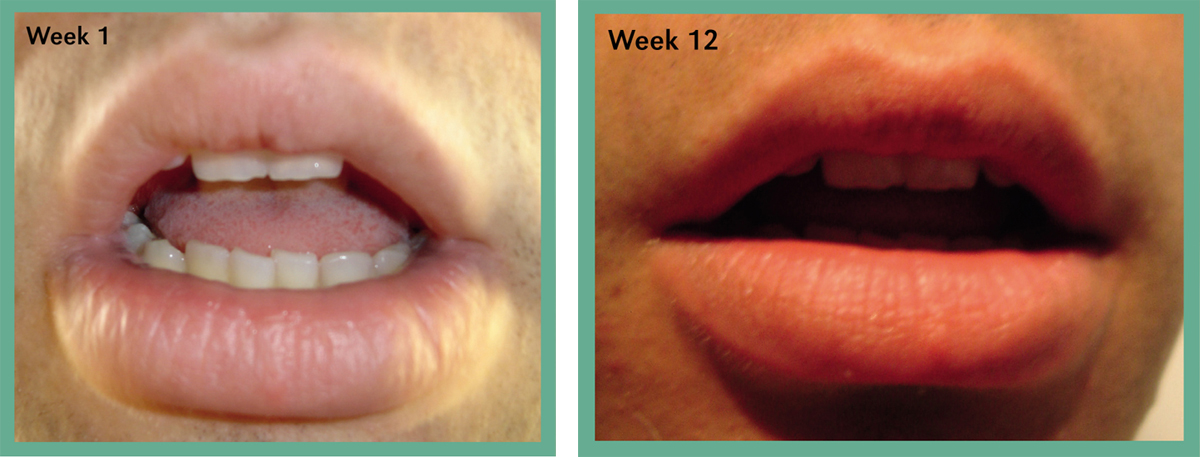
You can see that in week 1 I had dry and slightly cracked lips, but by week 12 I had supple and smooth lips thanks to my new diet and using lip balm.
EYES
Your eyes are a big give-away and say a lot about you, how you are feeling, and ultimately how healthy you are. As an organ, the eyes are a great source of information for detecting those early signs of ill health. This is why your doctor will still occasionally examine your eyes when you visit.
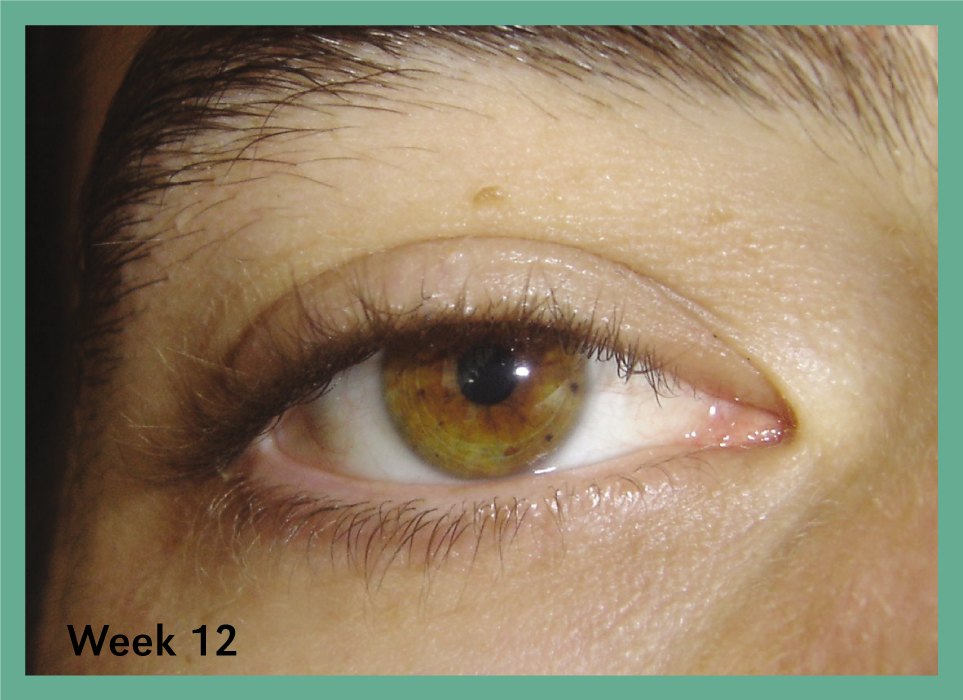
Our eyes have more than two million working parts, which make them the second most complex organ in your body (the first is the brain), and while some say eyes are the windows to the soul others have a more practical view.
Red and/or bloodshot – small blood vessels in the eyes become inflamed and dilated which causes bloodshot eyes. This may be caused by, or is an indication of, eye-strain, fatigue, colds, allergies, ocular rosacea, or a deficiency in vitamins B2 and B6 and amino acids commonly found in protein.
It is important to seek medical advice if you are suffering from bloodshot eyes along with any of these symptoms: severe headache, blurred vision, mental confusion, nausea/vomiting, or if you are seeing halos around lights. This may be an indication of an attack of acute glaucoma (a sudden increase in eye pressure).
Yellow eye – if the whites of your eyes turn yellow it could be a possible indication of a liver problem such as jaundice, gallbladder concerns, Gilbert’s syndrome, sickle cell anaemia, pancreatic cancer or yellow fever.
Dry eyes – this condition occurs when the eyes don’t produce enough tears to keep them moist. It is very common in women, especially after the menopause, due to the body’s reduction of the oestrogen hormone.
This could also be environmental, for example, due to windy, dry or hot air, or air conditioning. A sluggish thyroid, constant contact lens usage, a deficiency in omega-3 and omega-6, or a reaction to prescriptive and non-prescriptive drugs can also cause dry eyes.
Watery eyes – too many tears being produced could be linked to allergies, a deficiency in vitamin B2 or ocular rosacea.
Bags under the eyes – puffy pouches of skin under the eye. This is common as the skin around the eye ages and loses elasticity. Depression, insomnia or deprived sleep, crying, a high level of salt intake, a sluggish thyroid, fluid retention, kidney problems, or a bad reaction to medicine can encourage bags under the eye area.
Circles under the eyes – these could be indications of sleep deprivation, digestive problems, a sluggish liver, eczema or allergies.
Bulging eyes – possibly due to an overactive thyroid. It is important to visit your doctor if you suspect this.
Yellowish lump/bump on the cornea – if you notice these small yellow lumps, don’t worry, they tend to be age spots called pinguecula.
Spots on the eye – red spots on the whites of your eyes are usually blood vessels that have burst. It is normally caused by forceful sneezing or coughing, high blood pressure or injury.
NAILS
Your fingernails and toenails actually count as part of your skin, and are another great way of highlighting a number of medical and nutritional conditions. Nails are made of protein (keratin) and contain less water than skin, which makes them harder and protects the ends of the fingers and toes.
Fingernails take around four months to grow out, while toenails take at least six. If your nail growth is slower than average, it is possible that you have a fungal infection or a nutritional deficiency such as a lack of iron.
Healthy nails have the following characteristics:
•Texture – smooth, no ridges, thickness or cracks
•Shape – no exaggerated curving up or down at the ends
•Nail bed colour – pink
•Colour of nails – white
Here are some things to look out for when investigating your nails.
TEXTURE
Horizontal ridges – these go from side to side across your nail and can be an indication of a thyroid concern, stress, vitamin B deficiency, or the result of a nail injury that has stunted nail growth.
Vertical ridges – these go from the nail bed up to the tip. They may be due to nutritional disorders, a lack of iron, or a kidney disorder.
Pitted nails – this could be caused by lack of vitamin C, psoriasis, or deficiency in protein, and is a common sign for autoimmune disorders.
Thick nails – this could be a result of poor circulation, injury, fungal infection, poor diet or diabetes.
Rough nails – if they have a sandpaper-like texture, rough nails could indicate a skin or hair disorder such as psoriasis or eczema.
Brittle or cracked nails – often this is due to the use of harsh cleaning products, a thyroid disease, iron deficiency, vitamin A deficiency, or a lack of calcium.
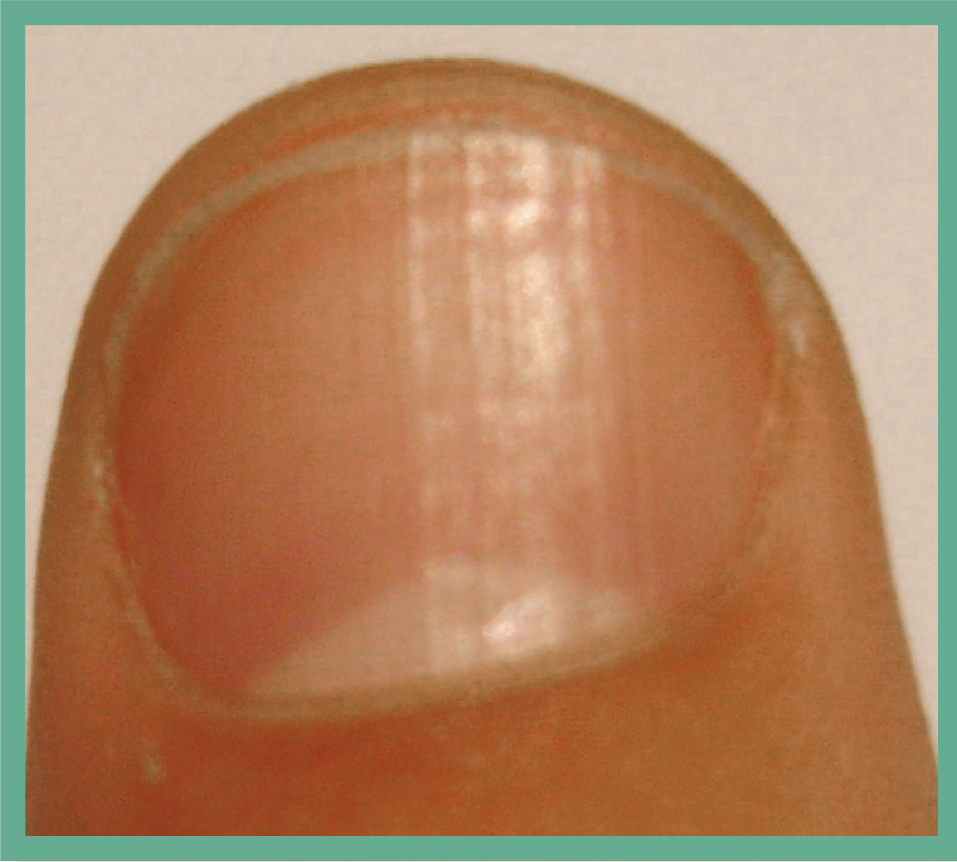
Looking at my thumbnail from week 1, you will notice that I have vertical ridges across the nail and a horizontal ridge at the top. This indicates nutritional deficiency.
SHAPE
Nails curve upwards (resembles a spoon) – could be a possible nutritional deficiency, a lack of iron, or a vitamin B12 deficiency.
Nails curve downwards (clubbed nails) – could be an indication of bowel disease, liver disease, or a lack of oxygen in the body. Once this condition occurs, it is normally permanent.
NAIL BED COLOUR
Blue – may be caused by a lung disorder.
Yellow – sign of a heavy smoker, jaundice, or yellow nail syndrome (this is a rare condition however).
Pale – possible sign of anaemia.
White spots – may be due to nail separation from the nail bed, nail warts, zinc or calcium deficiency, or systematic conditions that affect the skin, lungs and other organs.
HAIR AND SCALP
Our hair defines the overall health of a person like no other part of the body. You could say that our luscious locks are a barometer of our general health. Hair condition is a true reflection of the nutrition it receives from the scalp – so the better the diet, the better the hair condition.
Hair is made up from protein (keratin) and minerals, which go through the hair growth cycle. The hair has a growth phase, followed by a resting phase, and then a shedding phase. It then repeats the cycle. When we look at hair, we are looking at its condition, texture and volume to gauge how well our bodies are nourished.
Here are some things to look out for when investigating your hair.
CONDITION
Dry scalp – this could be due to the environment, hard water, poor diet, or the improper use of hair products.
Flaky scalp/dandruff – dandruff is not contagious and is not usually a serious problem. Some cases of excessive dandruff with intense itching and patches of flaky skin elsewhere on your body are most likely to be a form of eczema.
A flaky scalp may be caused by, or is an indication of, a fungus (malassezia), hormone changes, stress, neurological disorders, infrequent shampooing, skin ailments (psoriasis or infections), or the improper use of hair products.
Brittle and split ends – could be due to the environment, a poor diet, lack of protein and essential fatty acids, thyroid disease, menopause, excessive washing and drying, using bleaching and dying products, iodine deficiency, pregnancy, or the improper use of hair products.
VOLUME
Thinning hair/hair loss – this is normally determined by our genes and the ageing process, but may also be caused by a poor diet, lack of iron, or possible thyroid disease.
TEXTURE
Dry – this can be an indication of a poor diet, the environment, lack of protein and essential fatty acids, thyroid disease, menopause, excessive washing and drying, using bleaching and dying products, iodine deficiency, pregnancy, or the improper use of hair products.
Greasy/oily – occurs due to an overproduction of sebum, a waxy substance from the sebaceous glands, which keeps the hair supple, soft and waterproof. Fine hair tends to be greasier due to having more sebaceous glands. It may also be caused by genetics, the improper use of hair products, or a lack of regular hair cleaning.
SKIN
Our skin is a reliable indicator for assessing general health, as it is quite obvious when a person is run down, tired or ill by simply looking at their skin. Just think of all those skin creams and serums produced and marketed to millions of people across the world, claiming to dispel aged or tired looking skin. A good routine and a healthy balance is the basis for picture-perfect skin.
Our skin protects us from the environment, provides a unique barrier to infection, and helps excrete waste and toxins from within the body. It regulates and maintains a healthy balance of fluids and minerals, and is of course the source of our sensory receptors for touch. It is the largest organ of the body, and is indirectly linked to almost every part of your body, except the eyes and teeth.
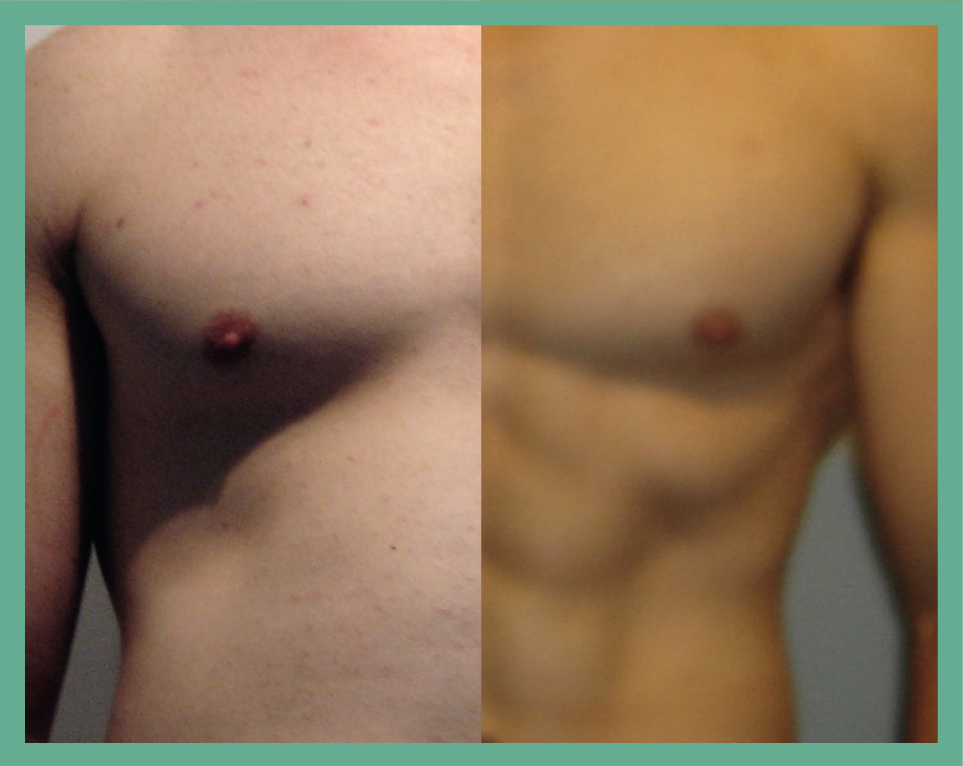
Look closely, and in the picture on the left you will see a breakout on my chest. But in the next you can see an amazing difference in my skin condition and physique.
Here are some things to look out for when investigating your skin.
COLOUR
Pale – could be an indication of anaemia or iron deficiency.
Blue tone – may be caused by oxygen deficiency in the blood, exposure to cold temperature, lung disease or heart disease.
Yellow tone – could be jaundice, the consumption of too much beta-carotene (foods such as carrots), or too much vitamin A.
Grey tone – can be caused by excessive smoking, a sluggish liver, cardiovascular disease or feeling unwell.
Red tone – rosacea, over-exertion, inflammation or burns can contribute to a red skin tone. Caught in the early stages, rosacea may cause flushing or blushing, but can progress to permanent redness. The rash consists of tiny pimples as well as dilated blood vessels under the skin and may be found on the face and body, which can cause an itching and burning sensation.
TEXTURE
Dark patches on the skin – possible indication of diabetes and insulin resistance, a hormonal disorder, or an adrenal gland concern.
Scaly rash – can be an indication of psoriasis, an infection or emotional stress.
It is common to find random lumps and bumps either on top of or beneath the skin surface from time to time, and most of these are harmless. Some however are not. If you notice a change in the size or shape of a lump or bump do not hesitate to see your doctor. Early detection of any pre-cancerous or cancerous cells will help treatment. Listen to your body.
FACIAL SKIN
We get oily and dry skin on both our body and face. Here are some things to look out for when investigating your facial skin more closely.
COLOUR
Rosy cheeks – these can be due to a hot flush, overexertion, rosacea, sun damage, or an autoimmune inflammation disease.
Dark patches – these can result from pregnancy, sun damage, a reaction to medication or contraceptive pills, or indicate high levels of oestrogen.
TEXTURE
Oily/greasy – caused by overproduction of sebum, a waxy substance from the sebaceous glands. This could be an indication of stress, pregnancy, hormone imbalance, medication, genetics, or poor diet (high intake of sodium, sugar and saturated fat). The improper use of cosmetic products or a deficiency in vitamin B2 could also cause an outbreak. It is not all bad news, however, your natural sebum slows down the signs of ageing.
It is important to highlight the difference between dry skin and dehydrated skin.
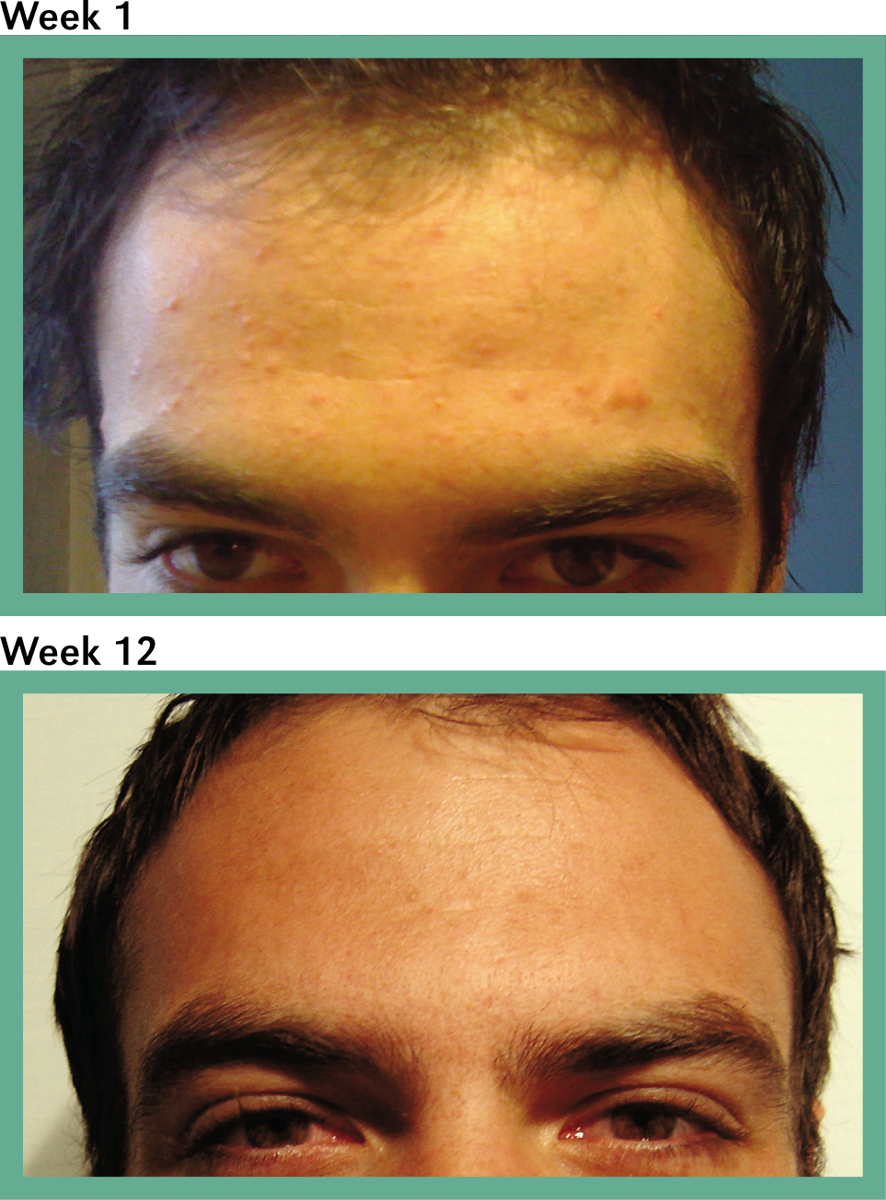
Look at the amazing difference 12 weeks can make to your skin with the right nutrition, cosmetics and advice.
Dry skin – this lacks the oils and moisture needed to keep skin supple and regulated. If your face never shows an oily shine and you’ve never even had a pimple (let alone acne), you are most likely to have normal to dry skin. Dry skin may be caused by genetics, or you may be deficient in essential fatty acids (omega-3, omega-6 and omega-9) and/or vitamins A and B. Hormones, skin disorders such as eczema, the environment, and the improper use of cosmetic products could also dry your skin.
Dehydrated skin – this is caused by a lack of water within the cells of the skin. If you have had visible pores, especially around your chin, nose or eyebrows and are prone to spots, but your skin has a dry and scaly appearance, you probably have dehydrated skin. It could be due to dehydration throughout your body, skin disorders (eczema), the improper use of cosmetic products or the environment.
Combination skin – this is characterised by oily patches in certain areas and dry/dehydrated areas in other parts of your face. The normal areas for the oily patch are known as the T-zone: the forehead, nose, cheeks and chin. This is due to these areas having more sebaceous glands than other areas of the face, like the eyes and jaw line. With this combination skin type, awareness must be given to the cosmetic products that you use so that you do not aggravate the problem areas further.
Sensitive skin – thin or fine-textured skin reacts quickly to hot and cold temperatures, and so is easily affected by the environment (sun burn and wind chills). This skin type is usually dry and delicate, and is prone to allergic reactions. Again, awareness must be given to the cosmetic products you use so as to not irritate the skin.
SKIN CARE ROUTINE
There are a lot of things you can do to keep your skin healthy, feeling fresh, soft and looking young. Maintaining a healthy diet, getting enough exercise, staying hydrated, avoiding any sun damage to the skin, and having low stress levels are all things that aid in keeping skin healthy. Following a skin care routine can also help. The skin care cycle has three main steps that should be followed daily to ensure a truly glowing complexion.
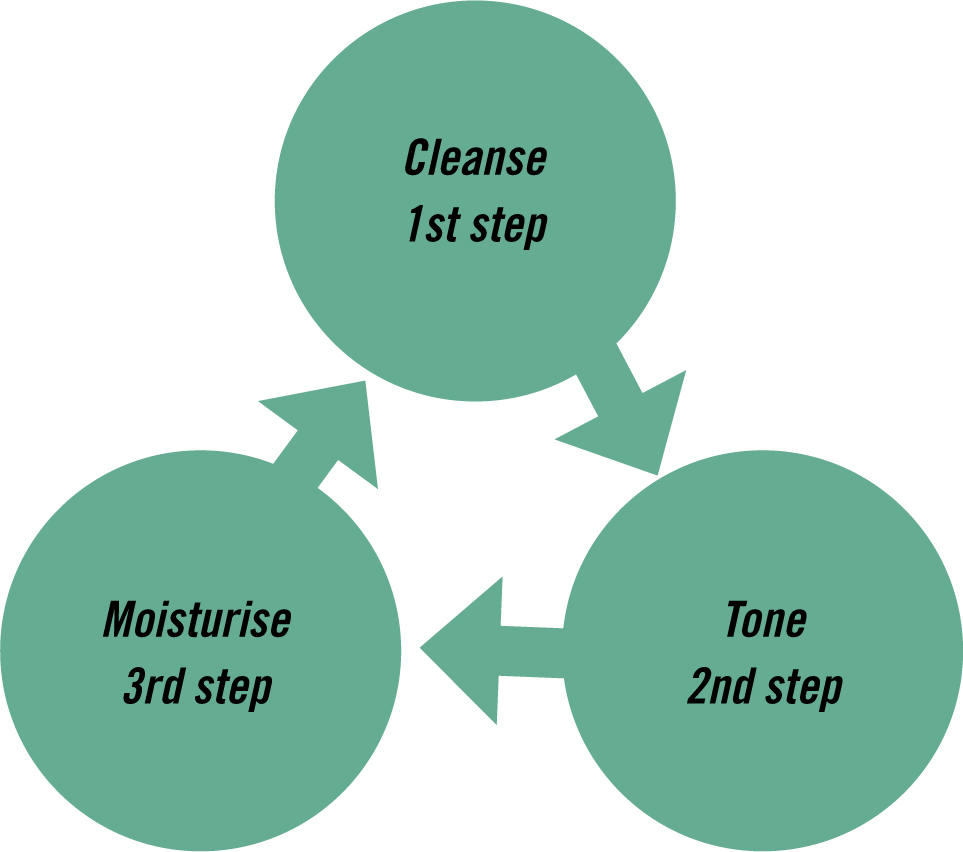
The three step skin care routine.
What is cleansing?
Throughout the day your skin is exposed to all kinds of things that clog up your pores, such as exhaust fumes, pollution, bacteria and dirt. Your skin naturally looses dead cells, excretes sweat (laced with toxins that your body is pushing out) and excess sebum.
By the end of the day, all this grime lies on the top of the skin and needs removing. When you cleanse, you remove this build-up. Oil-based, clay and scrub cleansers will also remove the top layer of dead skin.
What is toning?
This step is so simple and so often overlooked. Ultimately it is crucial to balance the skin, add nutrients and increase hydration. Toning removes any remaining grime left by the cleanser (which is especially important with oil-based cleansers), and will balance the pH of the skin. It will also aid in the tightening of pores, and helps the skin absorb oils more effectively.
What is moisturising?
This is the most important step in the cycle, and helps keep skin young and soft. Think about a piece of leather, for example. Adding oil keeps it from drying out, losing vibrancy and wrinkling. Cleansing removes the skin’s natural oils on dry skin, on oily skin it signals to the skin to stimulate more oil production often causing overproduction. By not replacing these oils, the skin must work harder to balance itself.
A moisturiser is not just oil, though – it should be a blend of good quality ingredients, as it sinks into the skin. Using a cheaper alternative often means cheaper ingredients that will have a long-term negative effect on the skin’s appearance.
LOOKING AFTER YOUR BODY
With all of the information you have just gained, you may now be wondering what you can do to help yourself.
One thing you may have noticed is that poor nutrition– lacking in vitamins and minerals – plays an important role in giving signs of poor health. By changing the way you eat, and by choosing a rounded diet that is nutritious and high in vitamins and minerals, your body will return to full health.
For any health concerns that you may have, you can help yourself in many ways, ranging from homeopathic remedies and supplements to holistic therapies. Whatever concerns you may have, remember there is nothing too big or too small for your GP. They are there to help you.
TAKE CONTROL OF THE BASICS
When we look at the basics for health, we are looking at the situations that we face every day of our lives. How we handle stress, how we overcome tiredness, and how we get the most out of ourselves.
It is these situations that change the way we look at life and make us into who we are. If we can take hold of these basics, we will be able to get more out of ourselves and others.
STRESS
We feel stress when pressure is placed upon us, whether actual or imagined. It can be harmful, but a certain amount can be good for us to help motivation, performance and productivity. Too much stress, however, can prompt depression, so please keep a close eye on yourself and others.
People react differently to stress; some have a higher threshold than others. Reasons for stress are very broad and unpredictable. It is a common fact that stress can be caused by demanding deadlines at work, the loss of a loved one, relationship concerns, financial pressures or illness. These and many more concerns can cause anxiety and stress, which can lead to physical, emotional and mental health problems. When we are faced with circumstances that are stressful to our mind and body, the body releases hormones (chemicals like cortisol and adrenaline), which help regulate our responses internally.
Adrenaline, for instance, is released to help us cope with dangerous or unexpected conditions. These invoke the ‘flight or fight’ impulse – the biological response to acute stress. It is interesting, however, that when faced with a situation in which you are prevented from either fleeing or fighting, such as being in a crowded underground station, these chemicals are not released. If you have a build-up of these chemicals due to them not being used the consequences are felt throughout the body, such as an increase in blood pressure, heart rate and sweat production.
Stress can cause single or multiple conditions. The list below is not meant to scare you, it is simply to emphasise the need to try to control and minimise any stress you may feel in your life:
•Heart disease
•Muscular tension
•Pain
•Diet
•Depression
•Weight gain/loss/obesity
•Digestive problems
•Sleep problems
•Autoimmune diseases
•Lower immunity causing more colds, feeling run down, etc.
•Raised cholesterol
•Skin complaints
STRESS RESPONSES
Stress affects our bodies in many ways and on many levels. Have a look below to understand your stress responses.
•Physiological – tension from posture or overuse.
•Emotional – anger, fear and hate are all reflected in our postures.
•Behavioural – posture imbalance from habit.
•Structural – the body and posture will change to meet any stress imposed upon it.
You can follow these steps to help control your own stress levels.
Step 1 – your stress levels
These are influenced by numerous things. The key is to have the knowledge and power to monitor your own responses, and to seek help or advice when something gets a little too much for you to cope with. How you take control is up to you.
Step 2 – your sense of control
Have confidence in yourself and your ability to perform. Support from friends and family will encourage you to look on the positive side and to share some of your concerns, and will act as a buffer for life’s stresses, resulting in you feeling less vulnerable.
Step 3 – your attitude
Try to have a more optimistic outlook. The ability to manage your emotions and bring them back into balance will enable you to become more calm and relaxed.
Step 4 – your understanding and preparation
Learn from past stresses and try to be prepared for similar future stresses. For example, when I broke my back in a diving accident, I knew it would be a long road to recovery so I rehabilitated slowly and professionally trying not to worry excessively about things. I made a full recovery and have continued diving with no worries.
KEEPING TRACK OF STRESS
During the 12-week programme I used the RPE scale to track stress levels. As you can see from the graph, stress levels were fairly high at the start, but gradually decreased by eating healthily, exercising and taking control of my body’s condition and lifestyle. The male results in the table are my results during the 12-week programme.
RPE (RATING PERCEIVED EXERTION)
The RPE scale is a simple method of measuring how a person handles stress on their body. The original scale was introduced by Gunnar Borg, who rated exertion on a scale of 6–20, although many health practitioners now use a revised scale of 0–10, developed by the American College of Sports Medicine. RPE can be applied to absolutely anything:
0Not stressed at all
1Very, very light stress
2Very light stress
3Fairly light stress
4Light amount of stress
5Moderately stressed
6Fairly stressed
7Stressed
8Very stressed
9Very, very stressed
10Stress is severely affecting life
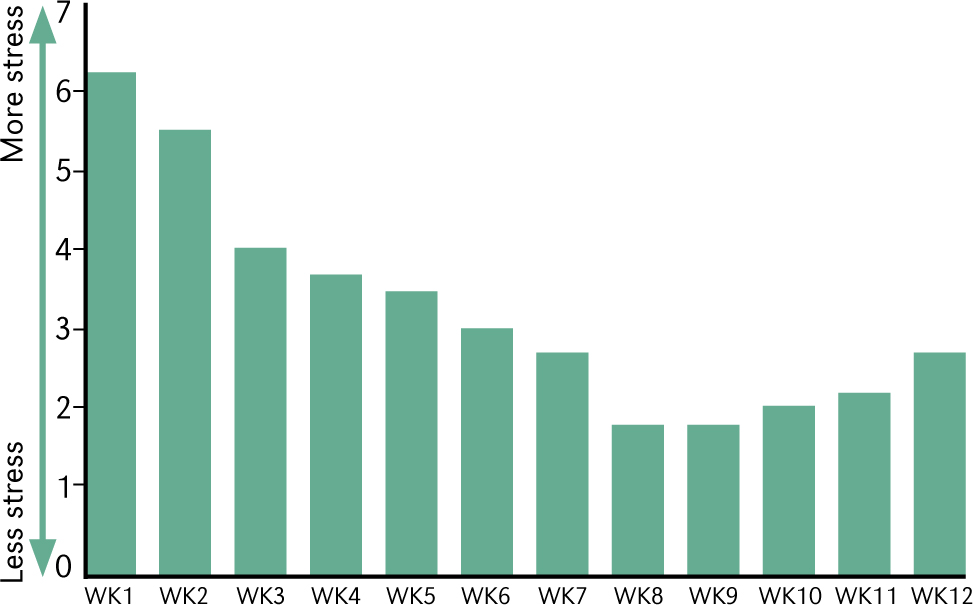
Stress level results
ENERGY LEVELS
It’s a fact: having more energy in the body fights fatigue and reduces stress levels. We have all felt tired and lacking in energy from time to time, especially during busy or stressful periods. But if you know the cause then the solution is often easy. More often than not, the reasons are found in our everyday life and habits.
Energy levels can be affected by your diet, how much sleep you get, and even your emotional state. There are many contributing factors that affect the balance of our emotional and physical state, which ultimately affect our energy levels. You should ask yourself how many of the following items are you managing to help keep your batteries charged:
•Having regular exercise
•Drinking plenty of water
•Eating a balanced diet
•Sleeping well
•Controlling stress levels
•Managing your emotional state
KEEPING TRACK OF TIREDNESS LEVELS
During the 12-week programme, use the RPE scale to track your progress in overcoming tiredness. We changed the stress scale to a tiredness rating:
0Not tired at all
1Very, very samll amount of tiredness
2Very small amount of tiredness
3Fairly small amount of tiredness
4Small amount of tiredness
5Moderately tired
6Fairly tired
7Tired
8Very tired
9Very, very tired
10Too tired to stay awake
The results show how I was handling my energy levels on a daily basis. As you can see, my tiredness levels were fairly high at the start of the 12 weeks, but gradually decreased as I started to eat healthily, exercise and basically gain control of my body and its condition. Although I did suffer from a fair amount of tiredness, I was able to manage it by following the steps above.
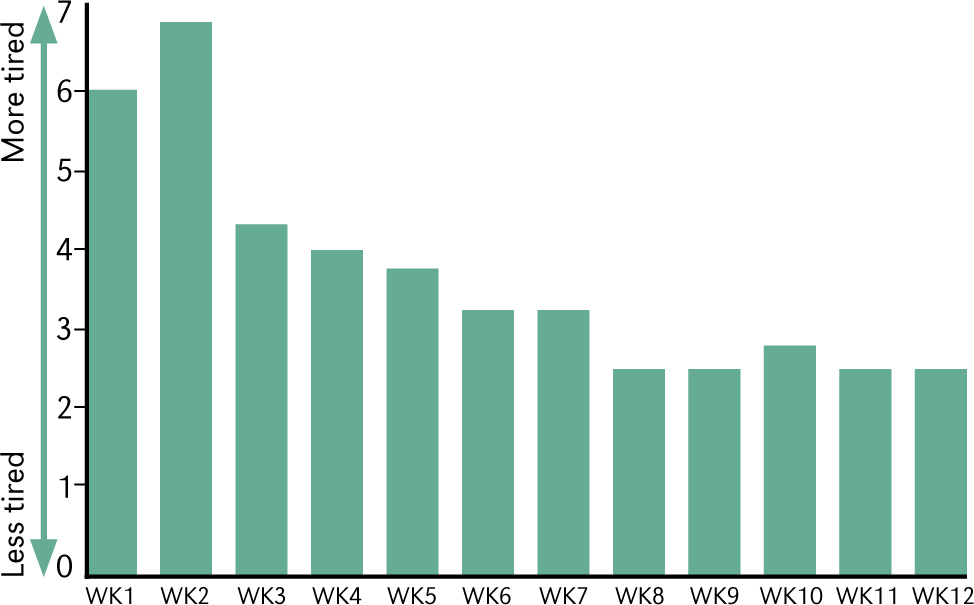
Tiredness level results
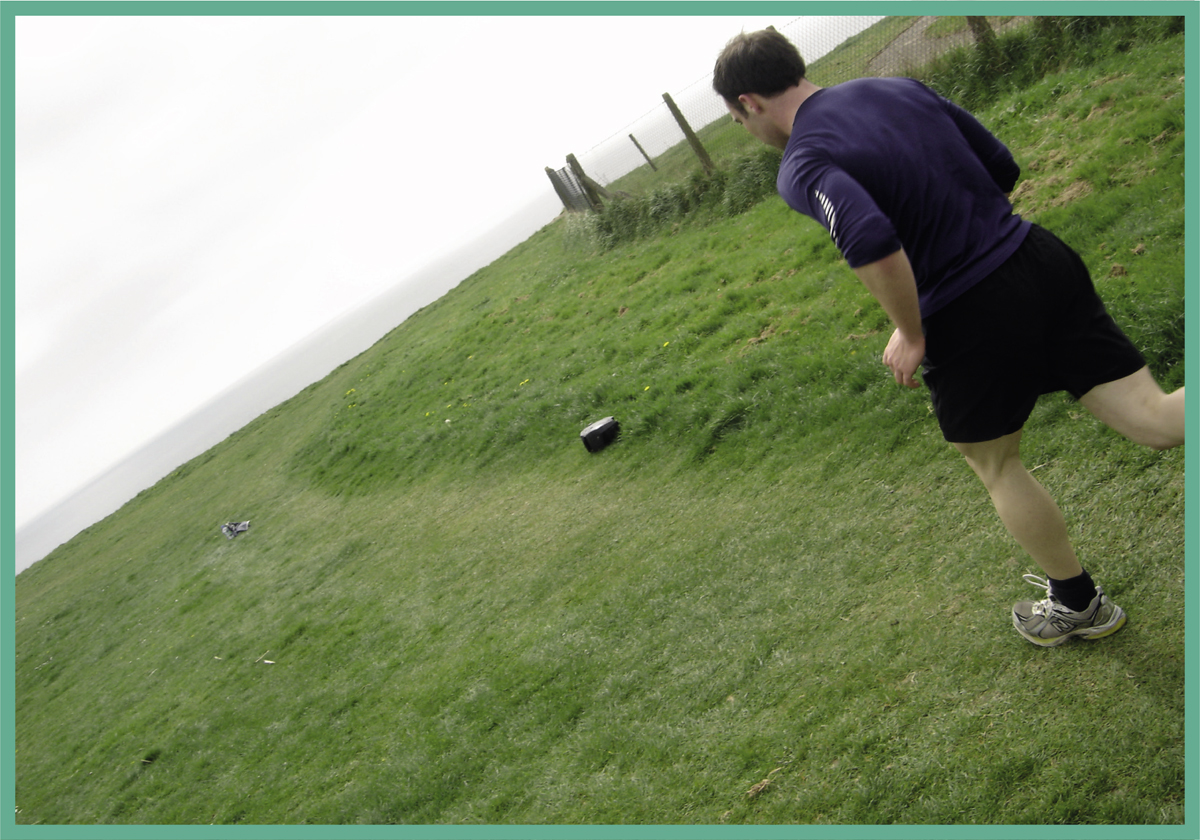
This is me running the bleep test on week 4. I never really like doing this test, but it has to be done to see how well training is going.
SLEEP
Sleep is as important as eating and drinking, which is why we spend one third of our lives doing it. It is absolutely vital for maintaining a normal level of cognitive skills, including speech, memory, and innovative and flexible thinking, and it gives the body a chance to recuperate and recover from all of the day’s activities.
We all become agitated and stressed when we are tired. The most simple and mundane tasks may become a source of stress due to sleep deprivation. Most adults need to sleep for around eight hours a night on a regular basis to function well, although some require more than others. It is believed the likes of Napoleon, Florence Nightingale and Margaret Thatcher all survived on just four hours sleep a night.
Sleep is triggered by hormones that are active in the brain, and respond to cues from the body and the environment. Some of our growth hormones trigger the release of proteins throughout the body to build and repair cells during sleep. Sleep deprivation can prevent this and affect the immune system.
Sleep occurs in a recurrent series of 90–110 minute bursts, and is divided into two categories relating to eye movement levels: REM (rapid eye movement) sleep, and non-REM sleep, which is about 80 per cent of all sleep.
During non-REM sleep, your breathing and heart rate slow and blood pressure will be low. This type of sleep is divided into four stages:
Level 1 transition between wakefulness to sleep
Level 2 makes up 50 per cent of sleep, slowing breathing and heartbeat
Level 3 very low respiration and heartbeat
Level 4 leads to rapid eye movement sleep known as REM, or Level 5
My average amount of sleep per night was six hours, 36 minutes, while my female counterpart slept on average seven hours and five minutes per night.
HYDRATION
Water makes up more than two thirds of the weight of the human body, around 60–70 per cent depending on size, shape and the amount of lean tissue (muscle). Muscle consists of approximately 75 per cent water, fat is around 14 per cent, blood has around 82 per cent, and lungs have 90 per cent. Astonishingly, the human brain is made up of 95 per cent water. A mere 2per cent drop in our body’s water supply can trigger signs of dehydration, and without water we would die within days.
Water is the most important nutrient for the body. It helps keep your cells, tissues and organs running smoothly, efficiently and effectively. Some of the ways water keeps your body working is by helping to keep it at a constant internal temperature, preventing constipation, and by cushioning your joints and protecting your organs. Fluids are vitally important when you are ill, particularly when you lose more water due to fever, diarrhoea or vomiting.
Your body needs a continuous supply of water to stay hydrated. By maintaining an adequate hydration level, your body will feel all the more healthy.
Reasons why water is special:
•Helps to fight fatigue and tiredness
•Allows you to exercise, train harder and maintain your strength
•Is the best detoxing agent available
•Helps digestion
•Regulates your metabolism
•Serves as a lubricant
•Forms the base for saliva
•Forms fluids that surround and protect joints
•Regulates the body temperature as cooling and heating is distributed through perspiration
•Helps get rid of waste
If you always wait until your mouth is dry to drink water, then you are probably waiting too long and are likely to be dehydrated. Dehydration causes a fuzzy short-term memory, trouble with basic cognitive skills and difficulty focusing on smaller print. Are you having trouble reading this? If so, drink up.
Water comes packaged in different forms, so you can have a little variety throughout your day. Did you know that a glass of milk or a serving of juice is actually about 90 per cent water? Some foods have high water content too, such as fruits, vegetables, yoghurts and soups. Enjoying these foods regularly can contribute to your water intake, and also provide you with many of the vitamins and minerals your body needs.
Here’s something to think about: a common mistake is confusing thirst for hunger, so why not drink water if you feel hungry between meals?
How much water is enough? It is recommended that we consume between 1.5 and 3 litres a day. During the 12-week programme I drank 1.5 litres a day (eight glasses) on average, and that’s excluding the fruit drinks, herbal teas and food I consumed. Don’t be put off by plain water. Add cordial to it to make it a little tastier.
POSTURE
Posture plays such an important role in the health of your body, but more often than not it is simply overlooked. The ideal skeletal alignment and consequent good posture involves teaching your body to stand, lie, walk and sit in positions that require the least amount of strain on supporting ligaments during any bodily movement. Having good posture keeps bones and joints in the correct alignment so that muscles are used correctly. It prevents fatigue because muscles are being used more effectively and therefore using less energy, and even contributes to a good appearance – more supermodel, less hunchback.
ANALYSING YOUR POSTURE
Your posture provides a lot of information about the state of your body. Postural analysis allows you to see which areas of the body are under more stress than others, which could result in the kind of backache that I was experiencing before starting the 12-week programme.
The easiest way to see if you have a good posture is to stand next to a plumb line to see if any body parts are out of sync. I use this method on clients to identify any postural faults and to help to distinguish which areas I need to strengthen or release. The side view posture test hypothetically divides the body into front and back sections of equal weight.
During the 12-week programme, you should take photos of your posture from the side and front to see the improvements in your posture. This method is not as accurate as if you were to visit a health professional, but it is something that can be done at home. Please note, you will need someone to help you with this test.
Set-up
Postural alignment equipment:
•Plain wall
•Plumb bob and line (coloured string if possible, available from most DIY stores)
•Picture hook
•Tape measure
•Camera
Tie the plumb line string to a picture hook in the ceiling in front of the wall you are going to stand in front of.
Standing barefoot, ensure the plumb line passes slightly forward of the ankle and approximately through the apex of the arch of the foot.
Then measure the distance between the wall and your feet, as well as between your feet themselves, and use these measurements to ensure you are positioned in the same way every four weeks when you take photos of your posture.
Analyse, compare and diagnose your own posture against that of a neutral posture using the following guidelines and pictures. If you have a misaligned posture then use the information given here to strengthen or stretch your muscles to realign yourself.
NEUTRAL POSTURE
In the neutral position, all the muscles are working in harmony with each other, and there are no elongated, weak, or short and strong muscles.

These photos show you the transformation that your body will undergo through 12 weeks. It is amazing how, with the right training, stretching and nutrition routines, and with a little help from the myo massage, your posture can be corrected.
If a person with a neutral posture stands side on, the plumb line should pass through the following areas:
•Head: lobe of the ear.
•Cervical spine: the neck presents a normal anterior curve.
•Thoracic: the thoracic spine should curve slightly in a posterior direction, and the plumb line should pass midway through the shoulder joint.
•Lumbar: the lumbar should curve slightly anterior.
•Pelvis: the front (anterior) and the back (posterior) of your hip should be at the same angle.
•Hip joint: slightly posterior to the centre of the hip.
•Knee: slightly anterior through the axis of the knee joint. The knee should be neither flexed nor extended.
•Ankle: past the ankle and through the apex of the arch of the foot.
•Feet.
Your feet should be in a neutral position, with your toes angled outward slightly at approximately 8 to 10°, and your heels together.
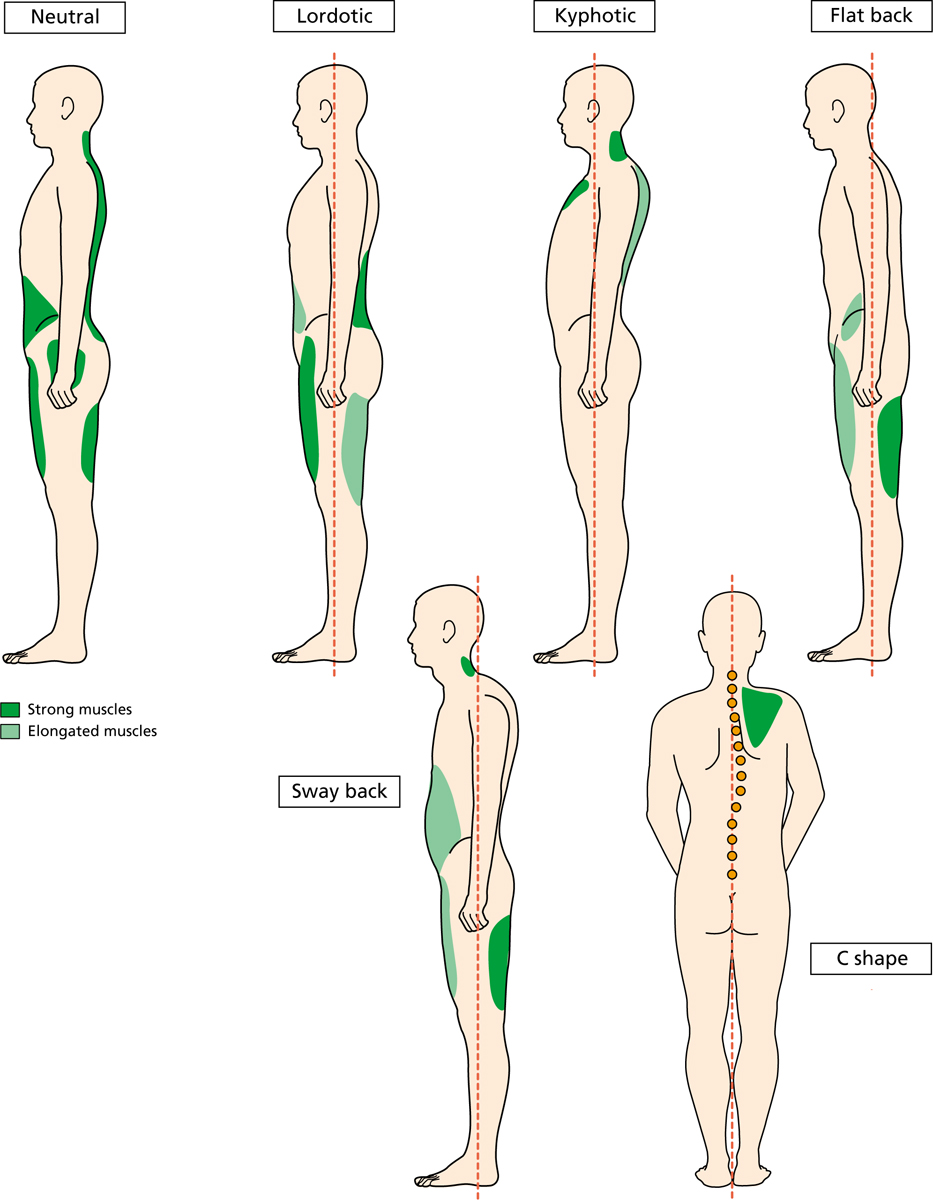
There are five common misaligned posture types illustrated on in the image above, and detailed below.
Posture type: Kyphotic Posture
Key features: Rounded and elongated upper back
Head: Forward
Cervical spine: Hyper-extended
Shoulder:
Thoracic spine: Increased flexion (increased posterior curve/rounded shoulders)
Lumbar: Neutral
Pelvis: Neutral
Hip joint: Flexed
Knee: Normal/neutral
Ankle: Normal/neutral
Lordotic posture
Key features: Bigger arch in lower back
Head: Neutral
Cervical spine: Normal/neutral (slight anterior)
Shoulder:
Thoracic spine: Normal/neutral (slight posterior)
Lumbar: Hyper-extended (greater curve in lower back)
Pelvis: Anterior tilt (tilts down forwards)
Hip joint: Flexed
Knee: Slightly hyper-extended
Ankle: Slight plantar flexion (toes point down towards floor as body leans on toes)
Flat back posture
Key features: No or limited arch in lower back
Head: Forward
Cervical spine: Slightly extended (causes head to tilt up)
Shoulder:
Thoracic spine: Increased flexion at top, straightens towards bottom (round shoulders into a straight lower back)
Lumbar: Hyper-flexed (lower back becomes straight)
Pelvis: Posterior tilt (backwards/up)
Hip joint: Extended
Knee: Slightly hyper-extended
Ankle: Normal/neutral
Sway back posture
Key features: Long curve from upper back to lower back; pelvis, spine and shoulders tilt slightly towards one side
Head: Forward
Cervical spine: Slightly extended (causes head to tilt up)
Shoulder:
Thoracic spine: Increased flexion (long kyphosis)
Lumbar: Flexion (flattening of lower back)
Pelvis: Posterior tilt (backwards/up)
Hip joint: Hyper-extended
Knee: Slightly hyper-extended
Ankle: Slight plantar flexion (toes point down towards floor as body leans on toes)
C-shape posture
Key features: Shoulder lower on same side as raised hip with curvature dependent on muscle strength and weakness
Head: Normal/neutral
Cervical spine: Normal/neutral
Shoulder: Elevated, adducted or slightly depressed (raised up, in or down)
Thoracic spine: Slight curvature either to left or right
Lumbar: Slight curvature either to left or right
Pelvis: Lateral tilt on left or right
Hip joint: Adducted and slightly medial rotated on one side (one side forward and in/down and other up)
Knee:
Ankle:
Elongated or weak muscles
Kyphotic posture: Neck flexors, upper back, external obliques, and hamstrings (slightly elongated but may or may not be weak)
Lordotic posture: Abdominals and hamstrings may or may not be elongated
Flat back posture: Hip flexors and the back may seem elongated with a flat back, but they may not be weak
Sway back posture: Hip joint flexors, external oblique, upper back extensors and neck extensors
C-shape posture: Lateral trunk muscles, the hip adductors (inside thigh), inside of calf muscles, and on the opposite side the hip abductors (gluteus medius muscle), and also TFL (front of hip) – side where pelvis tilts lower is weak side
Exercises to strengthen muscles
Kyphotic posture: • Reverse shrugs
• Bent-over lat raises
• T-bar row
Lordotic posture: • Reverse curl
• Reverse crunch
• Stiff leg deadlifts
Flat back posture: • Reverse crunch
• Deadlifts
• Dorsal raises
Sway back posture: • Bent-over row
• Single arm cable row
C-shape posture
Short or strong muscles
Kyphotic posture: Neck extensors and possibly your pectorals
Lordotic posture: Lower back and hip flexor/rectus femoris
Flat back posture: Hamstrings and the abdominals are frequently strong
Sway back posture: Hamstrings and the upper part of the internal oblique; lower back is normally strong but not short
C-shape posture: Hamstrings and abdominals are often strong. For instance, the hip/pelvis that is raised/tilted up has tight lateral muscles, hip adductors (inside thigh), inside calf muscles, and on the opposite side the abductors (gluteus medius muscle). Also look at the TFL (front of hip). Strong muscles are opposite side to weak muscles.
Exercises to stretch muscles
Kyphotic posture: Static stretch for the chest on a wall - trapezius stretch - Static stretch for the trapezius muscles
Lordotic posture: PNF stretch for quad lying face down - Developmental stretch for the lower back while lying down - Developmental stretch for hip flexor stretch
Flat back posture: PNF stretch for hamstring muscles - Developmental stretch for sitting hamstring muscles - Static stretch for the abdominal muscles
Sway back posture: Developmental stretch for sitting hamstring muscles - PNF stretch for hamstring muscles
C-shape posture
Scoliosis
An S-shape posture, where the shoulder is raised higher on the same side as a raised hip, could be scoliosis. Scoliosis is the abnormal curvature of the spine to the sides, which should be diagnosed by a doctor observing the movement in your back.
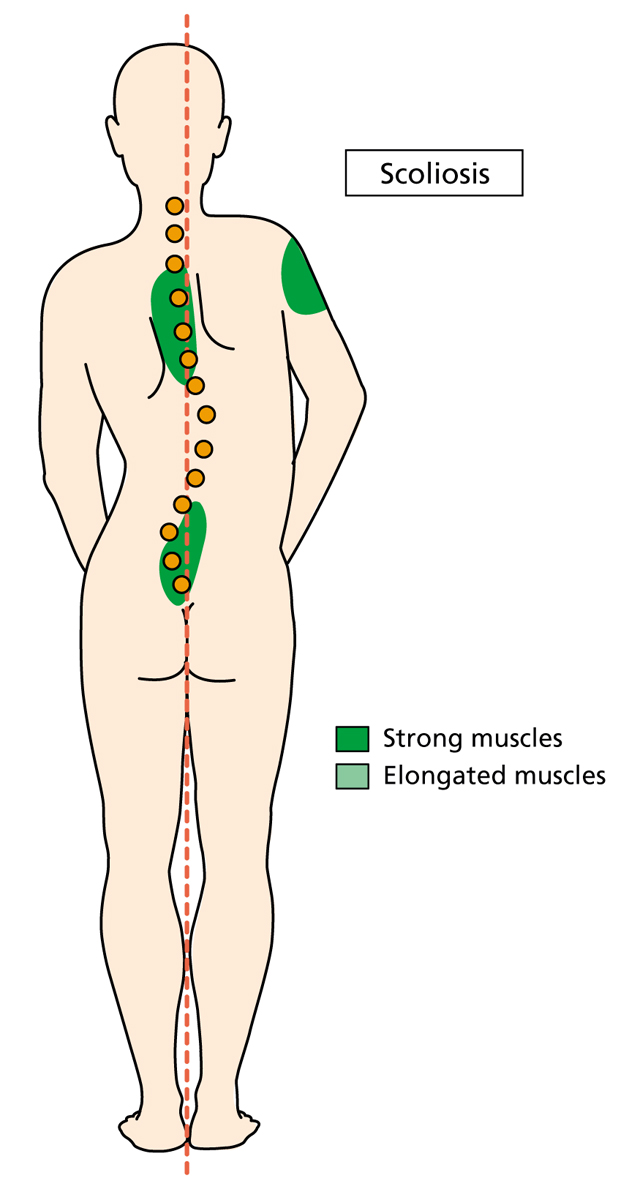
HELP TO REALIGN YOUR POSTURE
Now you can identify which category your posture falls into, you can take the correct steps to amend it by strengthening and shortening the weak muscles with exercise, and by elongating the short, strong muscles by stretching them. Exercises and stretches found within the 12-week programme can help with realigning posture, and massage can also help to alleviate muscular tension.
UNDERSTANDING AND TESTING YOUR BODY’S HEALTH
In order to monitor your progress and to demonstrate your eventual results, you should take health tests before, during and after the 12-week fitness and nutrition programme. We’ve opted for home testing instead of visiting a GP every week. These tests are not as accurate as those you may receive from your doctor, so perhaps visit your GP before and after your 12-week programme. This will ensure both sets of your results are accurate, and if you do have any health concerns before you start the programme, your doctor will be able to advise you.
Most of the home health-testing kits are easily available at a pharmacy or online.
Equipment needed for the health tests:
•Accurate scales
•Tape measure
•Glucose home test
•Cholesterol home test
•Callipers
•Body fat percentage reader
•Peak flow meter
•Watch
•Blood pressure monitor
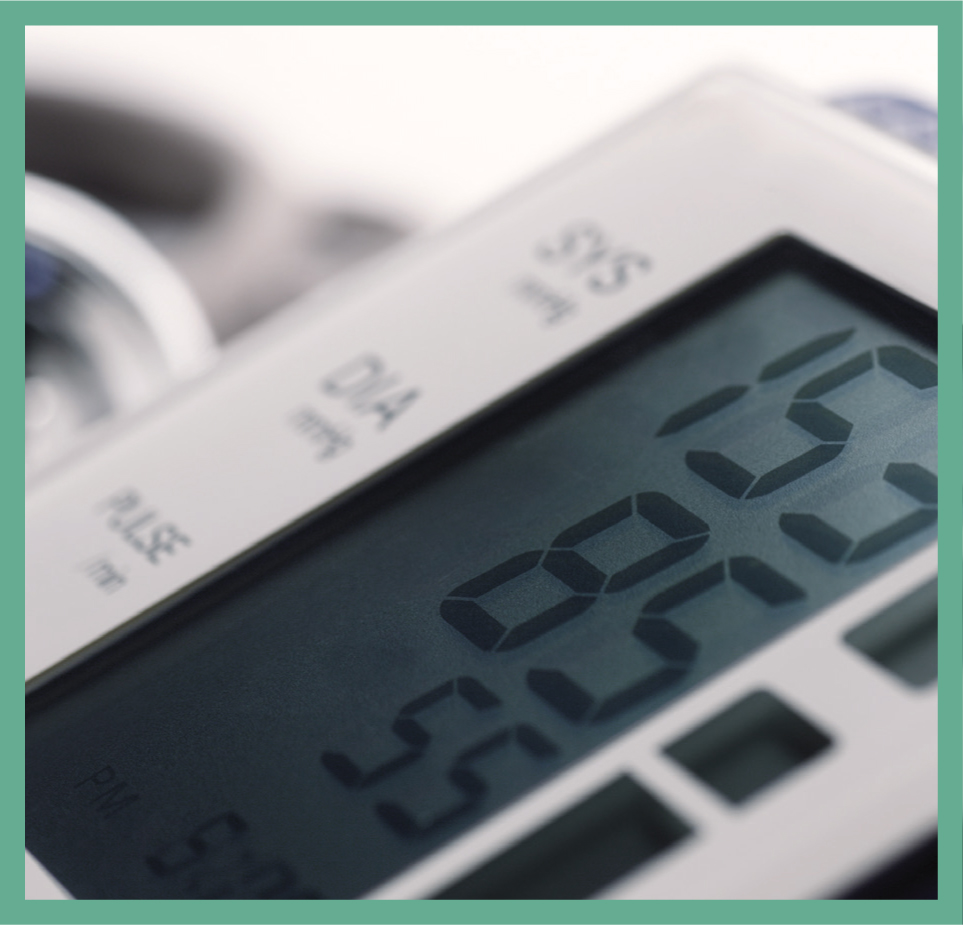
Blood pressure monitor
Each of the following tests was taken at the start of the programme, with some repeated on the last day of each week, and all taken every four weeks.
| Tests | Every week | Every 4 weeks |
| Height and weight | x | x |
| BMI | x | x |
| Resting heart rate (RHR) | x | x |
| Blood pressure (BP) | x | x |
| Body fat percentage | x | x |
| Measurements | x | x |
| Glucose | x | |
| Cholesterol | x | |
| Lung function | x | |
| Calliper tests | x |
HEIGHT AND WEIGHT
Although your height will give you no relevant information on its own, apart from telling you how tall or (in my case) how short you are, you will need it in order to work out your BMI.
Jumping on the scales every day is not the most accurate way to follow your progress, and try not to put too much pressure on yourself to lose a specific amount of weight each week. Don’t weigh yourself every day, as this can be very disheartening, but do it every Sunday on test day. You will need to weigh yourself to work out your BMI.
Body mass index (BMI)
There is no average weight or size that a person should be, but there is a method to discover if we fit into the general health practitioners’ recommendations. Using height and weight measurements we can use the BMI to determine a healthy weight for your height.
For the 12-week programme, we used a body fat percentage monitor for calculating BMI, but you can use the BMI equation below to calculate it if you don’t have one. It is a quick and effective technique to work out the weight range you are in:
Weight (kg) ÷ height (m) = x
x ÷ height (m) = BMI
For example, if you weigh 80kg and you are 1.75m tall, your BMI would be 26.1 (80 ÷ 1.75 = 45.7, then 45.7 ÷ 1.75 = 26.1). Using the chart below, you can see that the end figure would mean that the person is overweight. Please note, however, that BMI should not be used by bodybuilders or athletes as they have a higher than normal amount of muscle mass.
The BMI chart
| Underweight | 13–18 |
| Normal weight | 19–24 |
| Overweight | 25–29 |
| Obese/seriously overweight | 30–40 |
| Dangerously overweight/morbidly obese | 40+ |
RESTING HEART RATE (RHR)
This test measures your heart’s efficiency in pumping blood around the body when you are in a resting state. The RHR is able to tell you how fit you are, and by following the 12-week programme you should see a steady decrease in your heart rate as your heart becomes more efficient. Try and take your RHR readings as soon as you wake up in the morning, to get your best record.
You can find your RHR by simply finding your pulse on the thumb side of the wrist, and counting your heartbeat for one minute with your index and middle finger to see what result you have.
At the beginning of week 1 my RHR was 79 beats per minute, and by the end of week 12 it had decreased to 37 beats per minute.
The table overleaf shows the average RHR for a male. Mark where you are on the table to see how fit you are right now, and then mark it again in 12 weeks’ time.
Resting heart rate for men
| Age | 18– 25 | 26– 35 | 36– 45 | 46– 55 | 56– 65 | 65+ |
| Athlete | <55 | <54 | <56 | <57 | <56 | <55 |
| Excellent | 56– 61 | 55– 61 | 57– 62 | 58–63 | 57– 61 | 56–61 |
| Good | 62–65 | 62–65 | 63–66 | 64–67 | 62–67 | 62–65 |
| Fair | 66–69 | 66–70 | 67–70 | 68–71 | 68–71 | 66–69 |
| Average | 70–73 | 71–74 | 71–75 | 72–76 | 72–75 | 70–73 |
| Poor | 74–81 | 75–81 | 76–82 | 77–83 | 76–81 | 74–79 |
| Very poor | 82+ | 82+ | 83+ | 84+ | 82+ | 80+ |
BLOOD PRESSURE
Checking blood pressure is essential, as it directly affects your health. Blood pressure testing measures the strength of your heartbeat and the pressure of the circulating blood against the walls of your blood vessels. An ideal, healthy blood pressure is 120 over 80. The first number is your systolic blood pressure (the highest pressure when your heart beats), and the second number is your diastolic blood pressure (the lowest pressure when your heart relaxes between beats).
| Systolic | Diastolic | |
| Low | 70–90 | 40–60 |
| Ideal | 90–120 | 60–80 |
| Pre-high | 120–140 | 80–90 |
| High | 140–190+ | 90–100+ |
My blood pressure was at 130/92 in week 1, and after completing the 12-week programme it was 127/44.
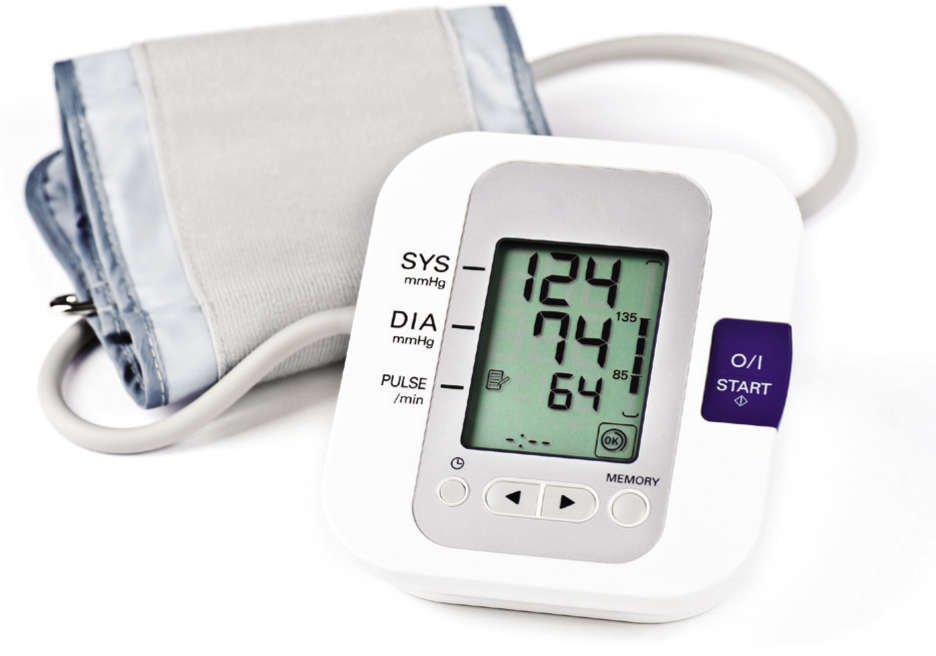
This is a blood pressure monitor similar to the one used in the 12-week programme.
BODY FAT PERCENTAGE
This is a quicker and more convenient version of the calliper test. However, the results are not quite as accurate. If you do this test every week it will allow you to see the change and will keep you on track.
There are a number of body fat monitor models available; some are similar to normal bathroom scales that you stand on with bare feet, others are hand-held. The monitor passes a low-level, imperceptible electric current through your body.
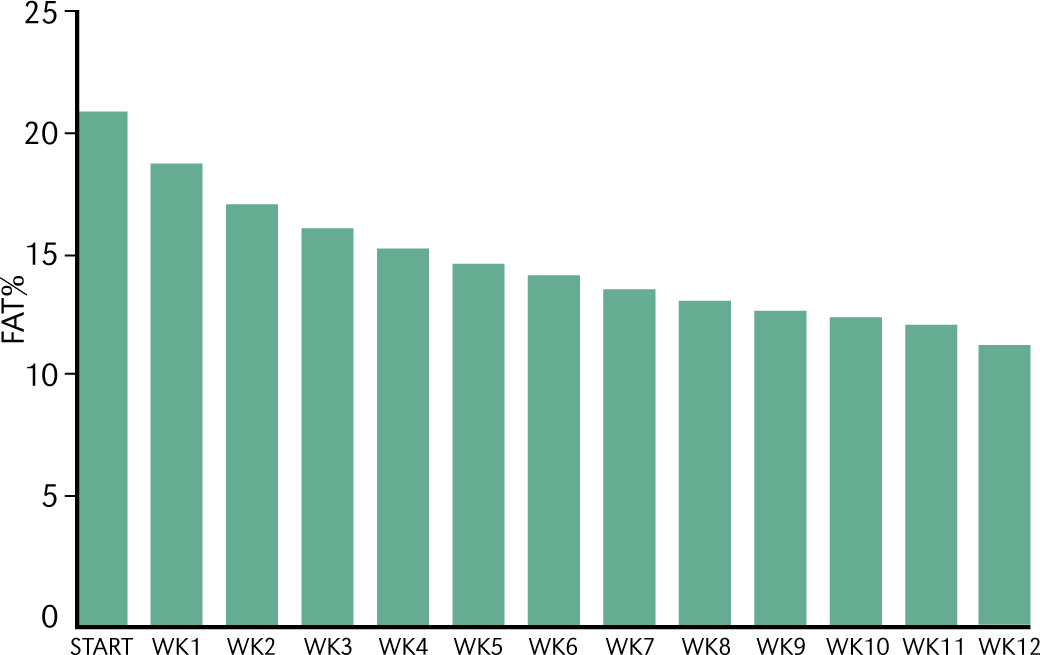
My body fat percentage results for the 12-week programme.
Fat contains limited water and is not a good conductor, so it impedes the current. As lean body tissue contains mainly water and electrolytes, this conducts the current throughout the body giving you a reading. By measuring your lean body mass, the monitor can predict your fat mass.
For best results, the monitors should be used at the same time of day, once a week, with minimal clothing being worn. You will also need to empty your bladder before use, as this will affect the results. Also, avoid alcohol and use the device straight after exercising.
MEASUREMENTS
I use measurements constantly with clients, as well as in my own training, as it is a great way to show how the body is reacting to your exercise and nutrition. With the results of your measurements and your fat percentage, you will be able to see if you are losing body fat rather than just losing weight (which may well just be fluid).
To take measurements accurately, you will need someone else to take them for you so your body can relax in a standing position. Take measurements while cold and relaxed, and at the same time every week throughout the 12-week programme. Please take careful note of exactly where you are taking your measurements from, and ensure that you measure from exactly the same place every time, in order to keep your results as precise as possible.
•Neck: measure down from where the ear lobe and jaw connect. The measurement will be down to the largest part of the neck. Take a note of the measurement, and then measure around the neck for the result.
•Chest: place the tape measure around the upper torso, measuring from the nipples and keeping the tape in the same alignment all of the way around.
•Upper arm: look at the arm and mark out the largest circumference. Measure up from the lateral epicondyle of the humerus (the bony bit on the outside of the elbow). Take note of the measurement, and then measure around the circumference for the result. Repeat for the opposite arm.
•Waist/naval: place the tape measure around your abdomen, measuring from the belly button and keeping the tape in alignment all the way around.
•Hips: place the tape measure around the hips over the anterior superior iliac spine (or the bony parts either side of your hip). Make sure the tape goes all of the way around and is in alignment with the front.
•Upper thigh: look at the widest part on the upper thigh and mark. Measure up from the head of the fibula (or the bony part on the outside of the top of the lower leg). Take note of the measurement, and then measure around the circumference for the result. Repeat for the opposite thigh.
•Calf: look at the largest part on the calf and measure around its circumference. Repeat for the opposite calf.
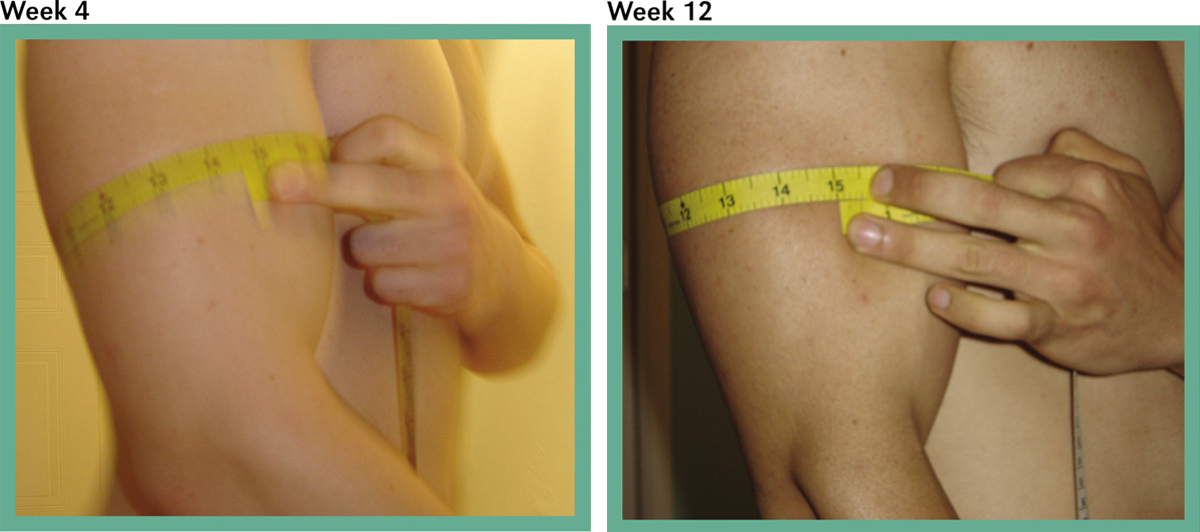
Not bad in just 8 weeks, a gain of 1½ inches.
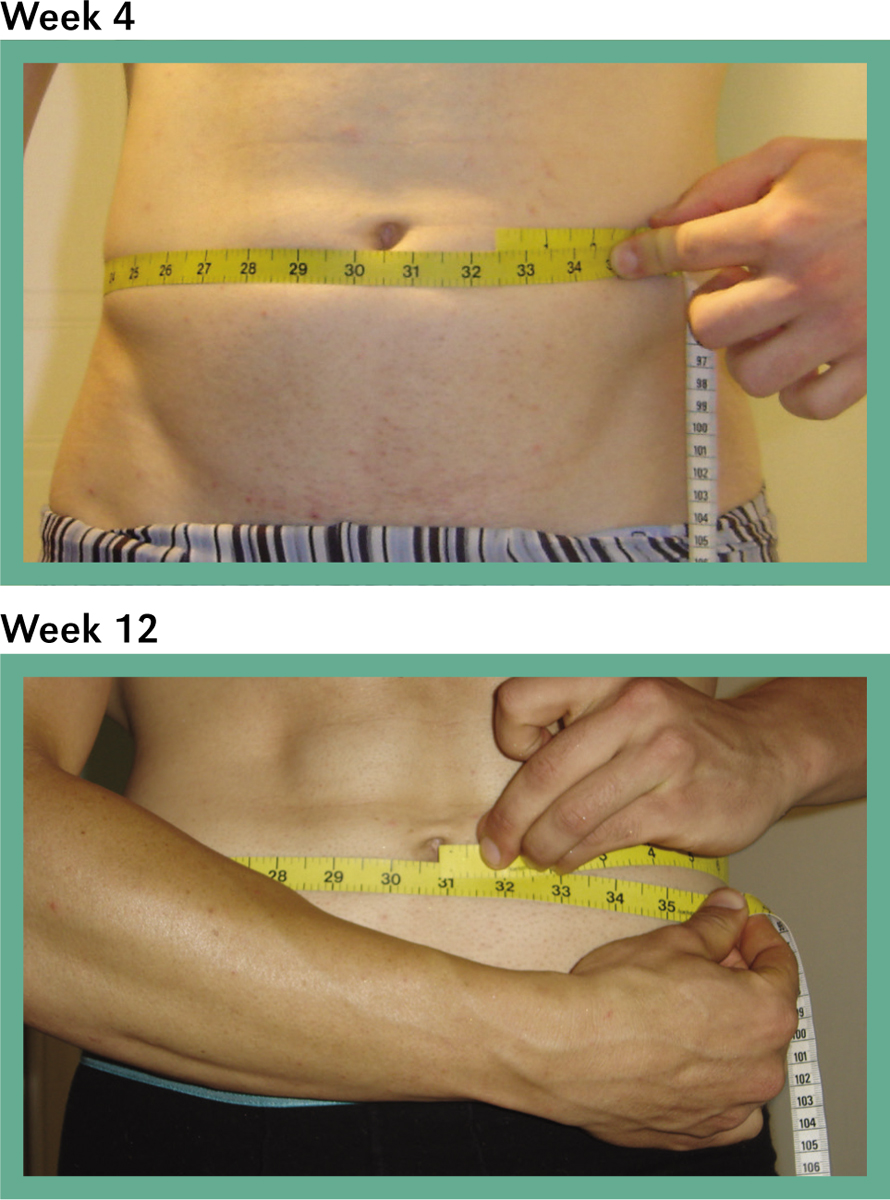
I lost a lot of inches from my waist, but this was not all body weight.
GLUCOSE TEST
This test measures the amount of glucose in the blood, and is used to detect hyperglycaemia (higher than normal glucose levels in the blood) and hypoglycaemia (lower than normal glucose levels in the blood). It also helps identify diabetes.
For the tests, we used a fasting blood glucose test for ease, which required eating no later than 10 p.m. the night before and taking the test at around 8 a.m. the following morning. Keeping the test criteria the same provides the best results. Please make sure that you read and follow the instructions on the specific test kit that you use.
The result guidelines for the fasting blood glucose test I took are in the table below, measured in millimoles per litre (mmol/l).
| From 3.6 to 6.0 mmol/l | Normal fasting glucose |
| From 6.1 to 6.9 mmol/l | Impaired fasting glucose |
| 7.0 mmol/l and above | Probable diabetes |
CHOLESTEROL TEST
Our bodies need a certain amount of cholesterol to make cell membranes, insulate nerves and produce hormones. Cholesterol is a waxy substance produced in the liver and other organs. We can also absorb cholesterol from foods such as eggs, red meat, cheese and more. Too much or too high a cholesterol level can affect your heart.
There are two forms of cholesterol, one of which is good for you while the other is bad.
Good cholesterol
High-density lipoprotein (HDL) picks up and transports surplus cholesterol from the body tissues back to the liver, where it is broken down and passed out of the body.
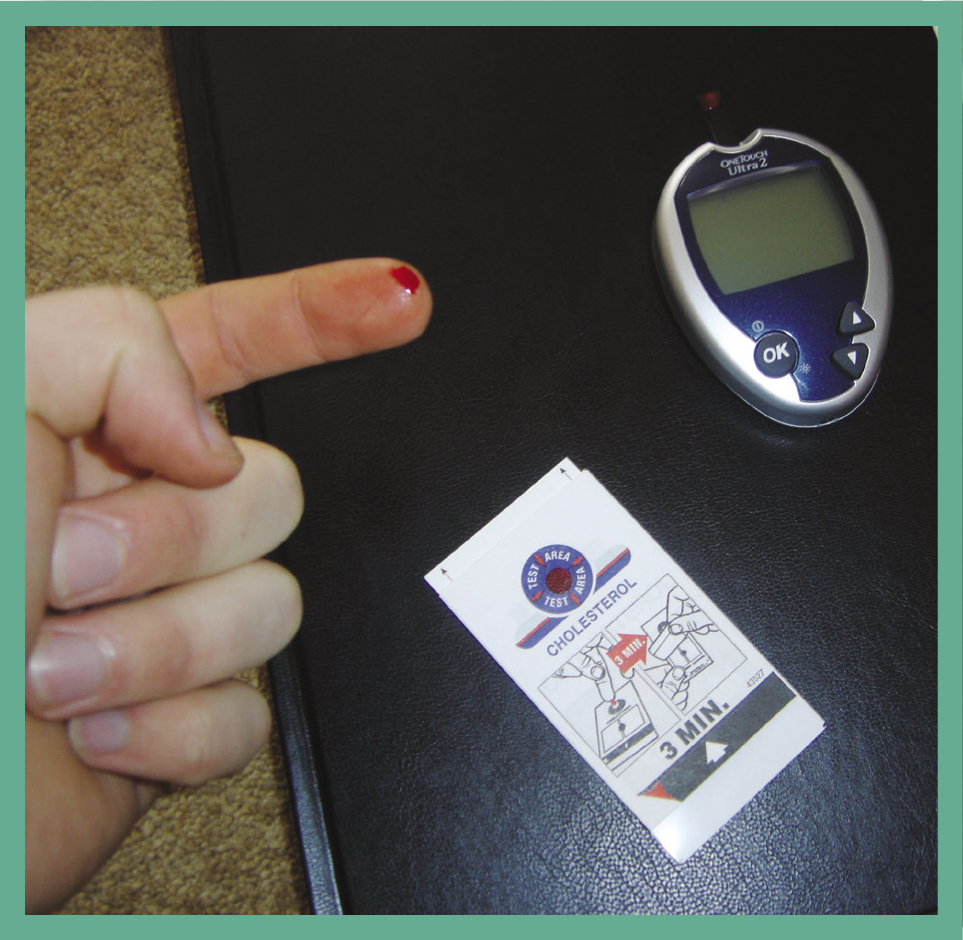
Bad cholesterol
Low-density lipoprotein (LDL) transports cholesterol from the liver around the rest of the body. When there is more LDL in the blood than the body needs, the cholesterol accumulates in the body tissues, such as the walls of the coronary arteries. Here it can build-up and affect the heart function.
A home test cholesterol kit
A home test kit simply measures the total amount of cholesterol. Please remember to read and follow the instructions. The levels of total cholesterol fall into the following categories, as shown in the table below.
| Ideal level | 3.9–5.2 mmol/l |
| Mildly high level | 5.0–6.4 mmol/l |
| High level | 6.5–7.8 mmol/l |
| Very high level | 7.8+ mmol/l |
LUNG FUNCTION TEST
The lung function test is measured by a peak flow meter, a small hand-held device used to measure how fast a person can exhale. The peak expiratory flow rate (PEFR) shows how well your airways are performing.
To measure PEFR:
•Breathe in as deeply as possible
•Blow out into the meter as hard and fast as possible
•Take note of its result and repeat three times and record your highest rate
Average male lung function results
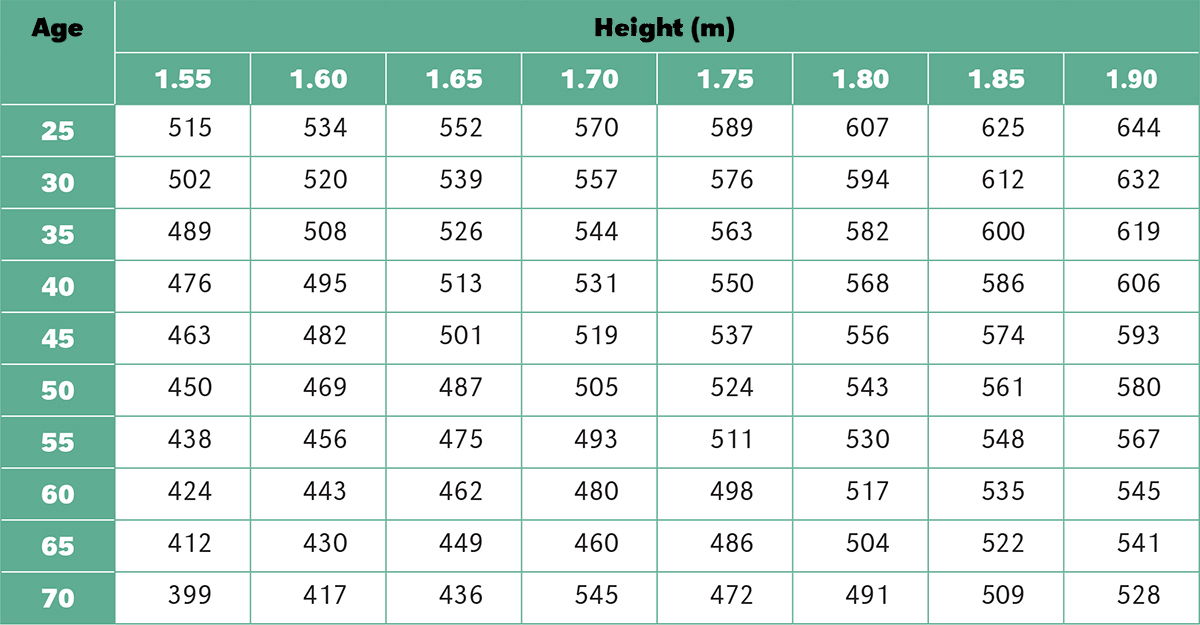
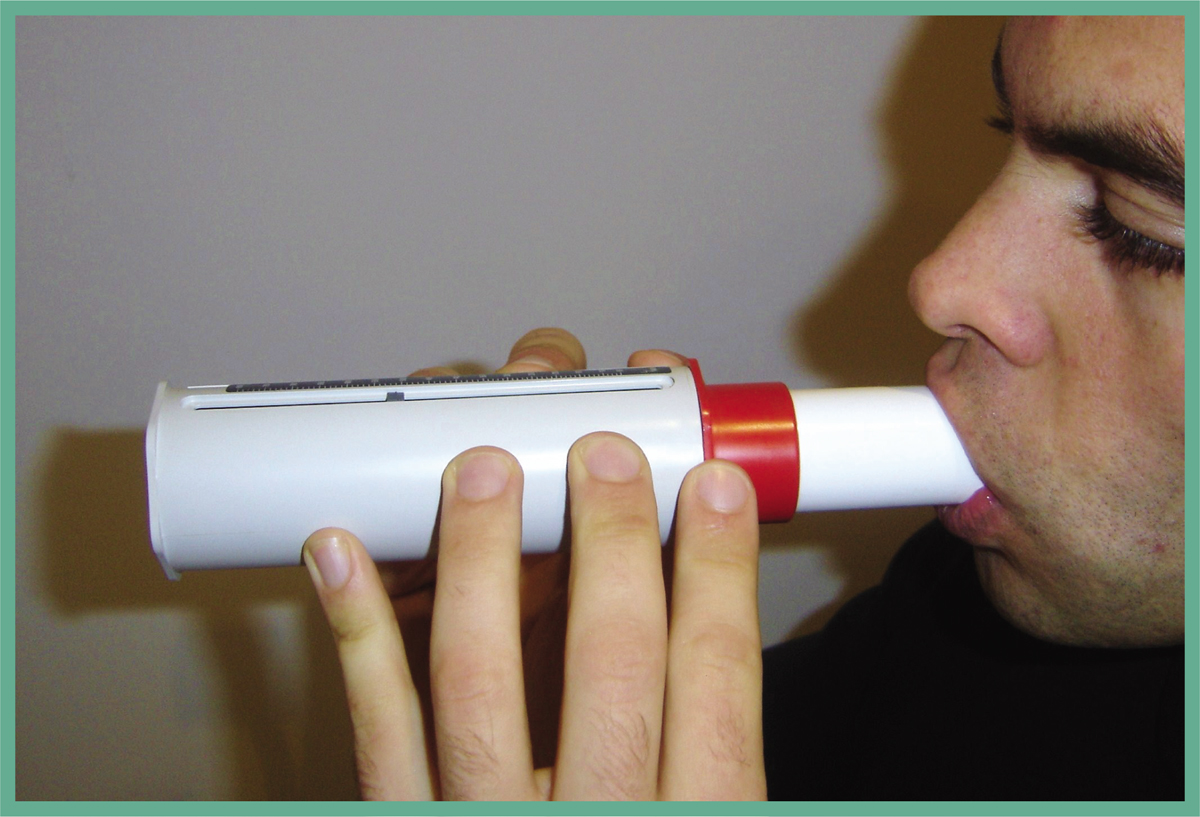
My lung function reading on the peak flow meter increased from 600 to 700 as my fitness improved on the 12-week programme.
CALLIPER TEST
This test measures skin folds to calculate your body’s fat percentage. You will need to have another person available to help take the measurements for this test, but again this can be done at home.
To take the calliper test
•Use the left-hand side for all of your measurements with your arms hanging freely.
•Pinch 1cm above the area being measured with the calliper.
•Measure all your calliper positions so that the next reading will be taken in the same place.
•The pinch should be maintained throughout the reading for a specific area before moving on towards the next area.
•Take the measurement a couple of times to gain the most accurate reading, allowing the skin to return to normal between readings.
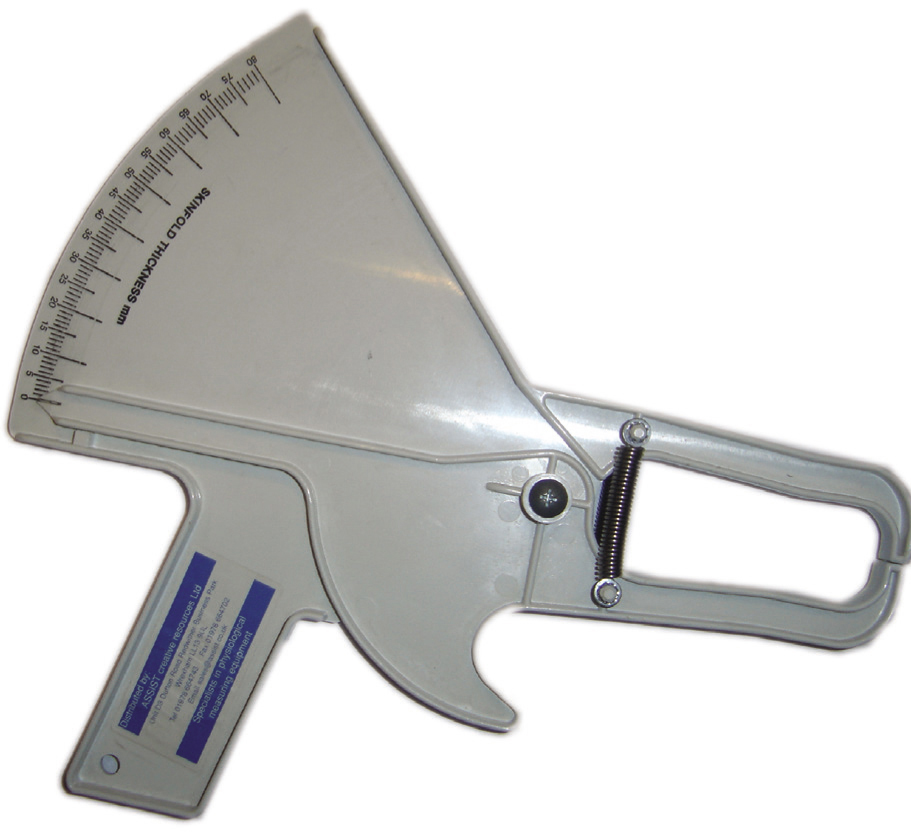
Calliper
Areas to measure
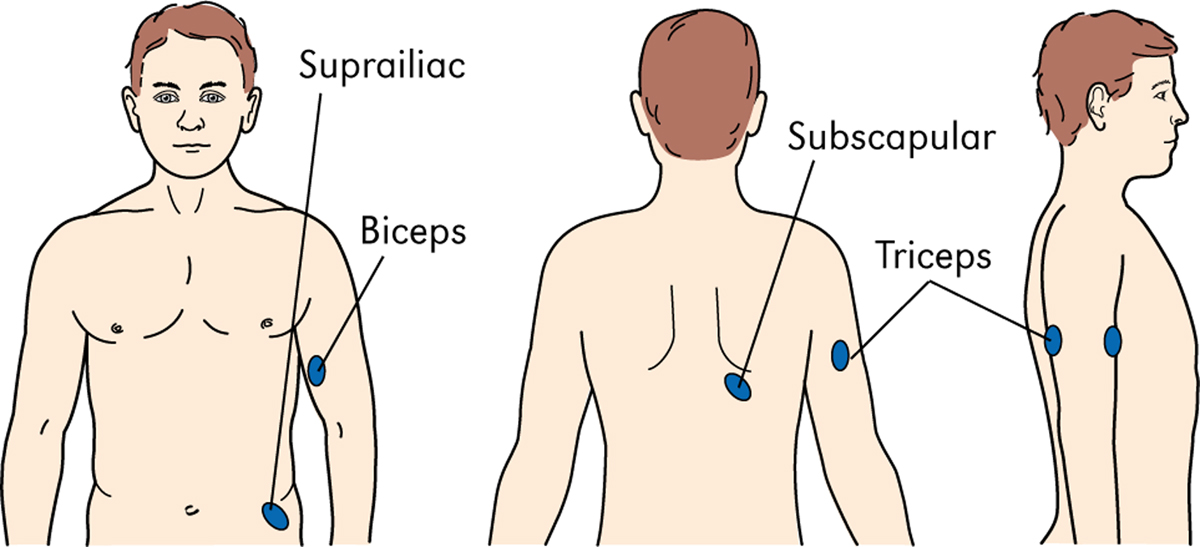
•Biceps – vertical fold for the pinch. Measure half way between the shoulder and the elbow directly on to the biceps to take the reading.
•Triceps – vertical fold for the pinch. Measure half way between the shoulder and the elbow directly on to the triceps to take the reading.
•Suprailiac – diagonal fold for the pinch. Measure directly above the hip.
•Subscapular – diagonal fold for the pinch. Measure 1–2cm down at 45° directly from the bottom of the shoulder blade.
Now add all four of your calliper measurements (biceps, triceps, superiliac and subscapular) together to get your total skin folds measurement. Apply your total skin folds measurement to the appropriate tables below:
Average male calliper test results
